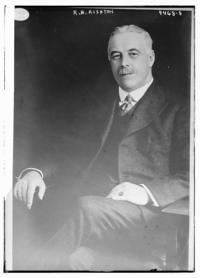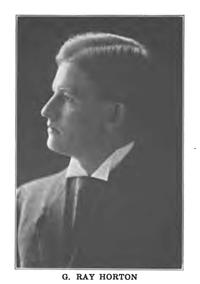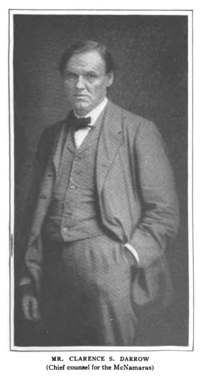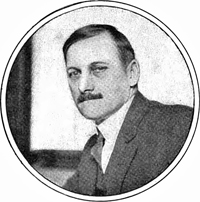The McNamara Brothers Trial
"Unionist Bombs Wreck The Times"
– Headlines from abbreviated edition of the Los Angeles Times, October 1, 1910, published at the facilities of the Los Angeles Herald."O you anarchist scum, you cowardly murderers, you leeches upon honest labor, you midnight assassins, you whose hands are dripping with the innocent blood of your victims, you against whom the wails of poor widows and the cries of fatherless children are ascending to the Great White Throne, go mingle with the crowd on the street corners, look upon the crumbled and blackened walls, look at the ruins wherein are buried the calcined remains of those whom you murdered."
– Editorial by General Harrison Gray Otis owner and publisher of the Los Angeles Times, October 1, 1910.
|
Year long investigation into the bombing of the Los Angeles Times and the deaths of twenty employees. The report concludes that the theory that leaking gas caused the explosion was wrong.
Defense Attorneys Ask Judge Bordwell to Recuse Himself.
Short transcript of meetings between McNamara defense attorneys and Judge Bordwell. The defense attorneys ask Judge Bordwell to recuse himself from the case but he denied the request. Courtesy of the Department of Special Collections, Stanford University Libraries.
Judge Bordwell's Deposition Denying Bias.
Judge Bordwell gave a signed deposition denying he was biased or prejudiced against the McNamara defense after the defense filed a motion to get the case transferred to another judge citing bias by Judge Bordwell. Courtesy of the Department of Special Collections, Stanford University Libraries.
Deposition of Job Harriman and Letter from J.H. Levering.
Part of a deposition of Job Harriman in regard to the defense hiring of J. H. Levering, an engineer to study the bombing of the Los Angeles Times. Also includes a letter from Levering to Judge Bordwell about Clarence Darrow. Courtesy of the Department of Special Collections, Stanford University Libraries.
The People of the State of California v. Matthew Schmidt, Appellate Briefs (1916).
Matthew Schmidt and David Caplan helped Jim McNamara purchase the dynamite that was used to bomb the Los Angeles Times building. Schmidt and Caplan were indicted in 1911 along with the McNamara brothers but they evaded arrest until 1915. Detective William Burns could find no trace of Schmidt until some I.W.W. members were killed by their own bomb in 1915. Burns' detectives discovered that the bomb was made of the same material and was similar in construction to the one used in Los Angeles by Jim McNamara. Schmidt was arrested on February 13, 1915 by Burns and a police captain in Los Angeles. Caplan was arrested five days later. Schmidt was convicted on December 30, 1915 and on January 12, 1916 he was sentenced to life in prison. Caplan's trial began in April 1916 but ended in a hung jury. He was retried and convicted of second degree manslaughter in December 1916 and was sentenced to ten years in prison. Courtesy of the LA Law Library.
Frank M. Ryan, president of the International Association of Bridge and Structural Iron Workers, and twenty-nine others were convicted of conspiracy and of transporting, aiding, and abetting the transportation of dynamite and nitroglycerin in interstate commerce in passenger trains and cars. The evidence in this case was the direct result of the investigation into the Los Angeles Times Bombing and involved substantial investigations in Indianapolis. Olaf Tveitmoe was also convicted and sentenced as part of this trial although he did not belong to the International Association. The case against Tveitmoe and five other defendants was remanded to the District Court for a new trial. During the retrial the court ruled that there was insufficient evidence to connect Tveitmoe to the conspiracy.
The bombing of the Los Angeles Times in which 20 people died was so shocking and traumatic that calls were made to investigate the causes of conflict between labor and industry. On December 30, 1911 a group of reformers led by Jane Addams and Rabbi Stephen S. Wise sent President Taft a petition, signed by numerous social reformers, professors and some businessmen, requesting that he create a commission to investigate the conflict that led to the bombing. President Taft agreed to form such a commission but he did not announce the names of commission members selected until December 1912, which was after he had lost his re-election bid to Woodrow Wilson. This allowed Wilson to choose his own members. The nine person commission was given a $100,000 budget and it held 154 days of hearings involving hundreds of witnesses. Among those called to testify were Clarence Darrow, General Otis, Walter Drew, William Haywood and numerous others with either pro-labor or pro-business viewpoints. The commission published its results in an 11 volume report in 1916.
Copy of Haywood's testimony republished by the Industrial Workers of the World (I.W.W.).
Testimony of Stephen "S.S." Gregory before the Commission on Industrial Relations.
S.S Gregory was a very prominent attorney and at one time the president of the American Bar Association. He worked with Clarence Darrow as associate counsel during the appeal of the Debs decision to the United States Supreme Court after the Pullman strike. He also worked with Darrow to try and save the life of Patrick Prendergast who was convicted and sentenced to death for the assassination of Chicago mayor Carter Harrison, Sr.
Los Angeles Ordinance 20586 (July 16, 1910).
Very controversial anti-picketing ordinance written by Earl Rogers as counsel for the Merchants and Manufacturers Association. The ordinance, unanimously adopted by the Los Angeles city council several months before the Los Angeles Times bombing, was aimed at disrupting union activities in Los Angeles. Rogers later lead the initial investigation into the Los Angeles Times bombing and subsequently defended Clarence Darrow against bribery charges.
Testimony of Clarence Darrow before the Commission on Industrial Relations.
Clarence Darrow testified on May 17, 1915.
Testimony of Walter Drew Before the Commission on Industrial Relations (1915).
Walter Drew was counsel for the National Erectors' Association and a strong proponent of Open Shops.
Testimony of Mr. William D. Haywood before the Commission on Industrial Relations (1916).
Haywood along with others, including Clarence Darrow, gave testimony before the Commission.
Testimony of Anton Johannsen before the Commission on Industrial Relations (1916).
Johannsen was a powerful San Francisco labor leader. It was widely believed that Johannsen and Olaf Tveitmoe arranged for the bombing of the Los Angeles Times building.
The Open and Closed Shop Controversy in Los Angeles (1916).
Begins with testimony from General Harrison Gray Otis on September 8, 1914. From volume 6 of the Final Report of the Commission on Industrial Relations.
Article about Earl Rogers who lead the initial investigation into the bombing of the Los Angeles Times building. He later defended Clarence Darrow against charges of jury bribery. Coincidently, the article was published on the same day the Los Angeles Times was bombed.
The Limits of Counsel's Legitimate Defense by John H. Wigmore.
Very critical commentary about Clarence Darrow''s handling of the McNamara defense by John Wigmore, Dean of Northwestern University Law School. 17 Virginia Law Register 743 (1912).
Does The American Bar Stand For It? (1912).
Article critical of Clarence Darrow's actions in the McNamara case. The article reprints Professor Wigmore's criticism and agrees with it. Published in "The Bar," the official journal of the West Virginia Bar Association.
Dynamite Conspiracy Case
Brief coverage of the trial of numerous members of the International Association of Bridge and Structural Ironworkers. This trial was a direct result of the investigation into the Los Angeles Times bombing. 20 Virginia Law Register 793 (Feb. 1915).
The McNamara Sentence Justified by Francis J. Heney.
From the Journal of the American Institute of Criminal Law and Criminology.
This critical commentary on the anti-union stance of the Los Angeles Times was written approximately three years before the Los Angeles Times Bombing.
Capitalism's Conspiracy in California: Parallel of the Kidnapping of Labor Leaders Colorado--California by Frank Wolfe (1911).
A pro-labor comparison between the arrest and extradition of the McNamara defendants with the arrest and extradition of the defendants in the 1907 Big Bill Haywood trial. Frank Wolfe, a journalist and former editor of the Los Angeles Herald, became a publicist for the McNamara defense and also ran as a Socialist candidate for city council.
A Letter from General Harrison Gray Otis (1914).
Obituary for Harrison Gray Otis followed by a letter that Otis wrote in 1914 to his son-in-law and daughter, Mr. and Mrs. Harry Chandler about the future of the Los Angeles Times. Otis was the President and General Manager of the Los Angeles Times.
Article from McClure's Magazine describing the extent of union power and influence in San Francisco.
The Story of a Reformer's Wife: An Account of the Kidnapping of Fremont Older, The Shooting of Francis J. Heney, and The San Francisco Dynamite Plots By Mrs. Fremont Older (1909).
From McClure's Magazine.
They Who Strike in the Dark by Will Irwin.
"True Stories of Plots, Abductions, Dynamiting and Attempted Murder That Have Been Undertaken Against Those Concerned as Witnesses, Lawyers or Supporters of the San Francisco Graft Prosecution." The American Magazine (1909).
Los Angeles Anti-Picketing Ordinance.
Criticism of the anti-picketing ordinance enacted in Los Angeles in 1910. Published in The Blacksmiths Journal.
The McNamara Case--Will They Get a Fair Trial?--Secretary McNamara Re-Elected (1911).
From the Locomotive Firemen's Magazine published by the Brotherhood of Locomotive Firemen.
A Militant Editor-General (1911).
Commentary on General Harrison Gray Otis published in Sunset magazine.
The Trial at Los Angeles by Christopher P. Connolly (1911).
Coverage of personalities in the McNamara case from Collier's.
Organized Labor's New Game (1911).
Criticism of Clarence Darrow's article "Why Men Fight for the Closed Shop." From American Industries: The Manufacturers' Magazine published by the National Association of Manufacturers.
What is the Matter with Los Angeles? (1911).
Article about the upcoming mayoral election in Los Angeles in which Job Harriman, co-counsel with Clarence Darrow in the McNamara case, was running for election on the Socialist ticket.
Detective Burns' Own Story of His Great Case (1911).
This article in McClure's Magazine describes the investigation led by William J. Burns into the dynamite campaign by the International Association of Bridge and Structural Ironworkers union.
Commentary on the Los Angeles Times Bombing (1912).
Commentary on the Los Angeles Times bombing and the factors leading to it and the need for a Commission on Industrial Relations. Includes a symposium of contributions from various prominent citizens. Published in The Survey.
What the Dictograph Is (1912).
Article about the dictograph bugging device. Briefly mentions its use in the McNamara case. Published in The World's Work.
How Burns Caught the Dynamiters (1912).
A short article from McClure's Magazine detailing William J. Burns' version of how he tracked down the McNamara brothers.
Gompers and Burns on Unionism and Dynamite (1912).
Interviews of Samuel Gompers and William Burns given to McClure's Magazine shortly after the McNamara brothers confessed to the blowing up of the Los Angeles Times Building.
Darrow's Lecture Scheme (1913).
Criticism of Clarence Darrow, his defense of the McNamara brothers, his receipt of money for lectures, and the American Federation of Labor. From The Review, a monthly publication of the National Founders' Association and National Trades Association.
Conspiracy Trial of International Association of Bridge and Structural Iron Workers union members (1913).
Article about the conspiracy trial of about fifty members of the International Association of Bridge and Structural Iron Workers union including their president, Frank Ryan. This trial was the direct result of the investigation into the Los Angeles Times bombing and was the largest criminal conspiracy trial in American history up to that time.
Labor and the Law as Viewed by Those Who Represent Each by Graham Taylor (1915).
Commentary and coverage of the United States Industrial Relations Commission. Published in The Survey.
Compilation of thirty-two articles critical of labor unions and union violence published in the Wall Street Journal during the fall and winter of 1922. It includes articles about the Los Angeles Times bombing.
Famous McNamara Case (1910).
Various editions of the Los Angeles Times published after the bombing. Quality varies due to microfilm.
Famous McNamara Case (1910).
The Washington Herald news article printed one day after the Los Angeles Times bombing.
Famous McNamara Case (1910).
The Washington Herald news article (Continuation).
The Los Angeles Times for 1911 and On (1911).
Defiant Los Angeles Times commentary written before the arrest of the suspects in the Los Angeles Times bombing. Published by the Times-Mirror Company in its "Emergency Publication Office."
Spied on McManigal in Cell (1911).
News about the use of a dictaphone in Ortie McManigal's jail cell.
The McNamara Fund (1911).
From the Box Elder news, this news article is critical of labor leaders and the amount of money collected from union members to help pay for the defense of the McNamara brothers.
Dictograph Near Darrow (1912).
News article about the covert bugging of Clarence Darrow's conversations with John Harrington in the Hayward Hotel in Los Angeles.
Burns Wins Over A Hostile Audience (1912).
The New York Times published this article about a speech given by detective Robert Burns before the Liberal Club that Lincoln Steffens helped form. The speech occurred about five weeks after Clarence Darrow was indicted for jury bribery. Speaking about the McNamara case, Burns told the audience: "With the best of motives in the world [Steffens] was simply taken in by the clever Darrow. Darrow led him to believe that his proposition was being given weighty consideration. What he did not know was the pressure we had on Darrow that made the saving of Darrow a thing of prime importance. C.P. Connolly took the view of the case that Darrow moved to save Darrow, and Connolly was dead right."
Bomb Attack in Darkness (1919).
A newspaper account of the firebombing of Oscar Lawler's home which nearly killed him and his family in 1919. The attack was not related to the McNamara case but involved another person prosecuted for industrial warfare.
Very critical commentary on labor unions in San Francisco.
The National Dynamite Plot: being the authentic account of the attempts of union labor to destroy the structural iron industry by Ortie McManigal (1913).
Ortie McManigal's confession of the nationwide sabotage campaign alleged orchestrated by the International Association of Bridge and Structural Iron Workers union.
The Masked War by William J. Burns (1913).
Burns version of the detective work performed by him and his agency to apprehend the McNamara brothers for bombing the Los Angeles Times building and the related investigation of the International Union of Bridge and Structural Iron Workers for dynamite sabotage.
The National Erectors' Association and the International Association of Bridge and Structural Ironworkers by Luke Grant (1915).
Comprehensive study of the labor troubles between the National Erectors' Association and the International Association of Bridge and Structural Ironworkers prepared for the United States Commission on Industrial Relations.
"The System" As Uncovered by The San Francisco Graft Prosecution (1915).
Earl Rogers played an important role in defending Patrick Calhoun, president of United Railroads of San Francisco, during an extensive graft prosecution in San Francisco involving corruption and bribery of public officials.
Cases and Other Authorities on Legal Ethics by George P. Costigan, Jr. (1917).
This excerpt from a law school casebook published in 1917 is identified by a reviewer as perhaps the first casebook to provide a selection of cases as the basis for a course of instruction in legal ethics. The book uses Clarence Darrow's actions in the McNamara case and Darrow's subsequent bribery trial as examples. When Darrow learned that the author was going to publish these examples, he contacted the author, who published a written statement by Darrow.
Ironworkers 100th anniversary, 1896-1996 : A History of the Iron Workers Union (1996).
Cover and chapters 1 & 3 of this 100th anniversary book. Chapter 3 covers the Los Angeles Times bombing. Used with permission from the International Association of Bridge, Structural, Ornamental and Reinforcing Iron Workers.
Bio of Cyrus F. McNutt, a retired Indiana judge, who assisted Clarence Darrow during his defense of the McNamara brothers.
Mr. Otis and the Los Angeles "Times" (1915).
Criticism of General Harrison Gray Otis "Prepared by an Authorized Publicity Committee of Los Angeles Typographical Union No. 174."
William J. Burns Advertisement.
This advertisement for detective William J. Burns calls him "The Greatest Silent Factor In American Public Life."
Miscellaneous Letters Written to Judge Bordwell and the Grand Jury (1911).
Courtesy of the Department of Special Collections, Stanford University Libraries.
Proceedings of the Asiatic Exclusion League (1907).
The Asiatic Exclusion League was a racist labor organization formed to prevent Asians from competing for jobs. It's formation on May 14, 1905 in San Francisco is the official beginning of the anti-Japanese movement. Among those attending the first meeting were labor leaders Patrick Henry McCarthy and Olaf Tveitmoe of the Building Trades Council of San Francisco. Tveitmoe became the first president of the organization. Tveitmoe was a major figure in the labor troubles that led to the bombing of the Los Angeles Times. He was believed by the prosecution to be one of those behind the bombing. He also allegedly laundered money for Clarence Darrow to be used for jury bribery. McCarthy was an influential labor leader in San Francisco and Mayor of the City from 1910 to 1912.
Proceedings of the Asiatic Exclusion League (1908).
Contains an editorial written by Olaf Tveitmoe, president of the Asiatic Exclusion League, about proposed legislative changes to the Chinese Exclusion Act.
Letter from Father of the McNamara Brothers to Judge Bordwell (1911).
John A. McNamara wrote this letter to Judge Bordwell asking for mercy for his sons. Contains copies of the transcription and the handwritten letter. Courtesy of the Department of Special Collections, Stanford University Libraries.
Clarence Darrow's statement given to newspapers the day of the McNamara Brothers' guilty plea (1911).
Clarence Darrow's statement explaining why his clients pled guilty.
Judge Bordwell's Response to the Father of the McNamara Brothers (1911).
This typed letter, along with a handwritten draft, was written by Judge Bordwell in response to John A. McNamara's plea for mercy for his sons. Courtesy of the Department of Special Collections, Stanford University Libraries.
Statement given by Clarence Darrow to Newspapers After McNamara Brothers Plead Guilty (1911).
Clarence Darrow's explanation for why he had his clients plead guilty. The guilty pleas were so shocking and unexpected that Darrow must have felt compelled to offer his reasons.
A Federal Commission on Industrial Relations--Why it is Needed (1912).
Article discussing the need for the Commission on Industrial Relations created in the aftermath of the Los Angeles Times bombing. Published in the Proceedings of the Academy of Political Science.
George Ray Horton.
Short bio of George R. Horton, a young assistant district attorney who worked on the McNamara prosecution. Published in the Press Reference Library (1912).
Joseph Scott.
Bio of Joseph Scott who was part of the McNamara defense team. The bio was written as the McNamara case was still pending. From the Press Reference Library (1912).
Report of McNamara Defense Fund (1912).
Published in the Railway Carmen's Journal.
Petition to the President for a Federal Commission on Industrial Relations (1921).
In the aftermath of the Los Angeles Times bombing and the McNamara guilty pleas, this petition was presented to President Taft on December 30, 1912 asking him to appoint a commission to study industrial problems between labor and capital. The petition led to the formation of the Commission on Industrial Relations.
The Field Before the Commission on Industrial Relations by Paul U. Kellogg (1913).
Discussion of the factors leading to the creation of the Commission on Industrial Relations. 28 Political Science Quarterly pp. 593-609 (Dec. 1913).
Famous McNamara Case.
Speeches by Anton Johannsen, Clarence Darrow and Mother Jones given at a labor meeting in 1915.
Some Phases of the Labor Question (1921).
Speech given by Walter Drew, commissioner of the National Erectors' Association.
Photos - Key Figures

"Mr. Gompers, with several other members of the executive board of the American Federation of Labor, came to see me and asked me to assume the defense. I urged them to get some one else. Of course I realized that the men should be defended, but I felt that I had done my share of fighting. It was not easy to combat the powerful forces of society in the courts, as I had doing for many years . . . . But the representatives of the Federation of Labor were so urgent that at last I could not refuse. How many times thereafter I wished that I had insisted upon some one younger and stronger and more anxious for the task. But I could not turn back. It seemed destined that I should take that path."
LC-USZ62-19862, Library of Congress Prints and Photographs Division Washington.





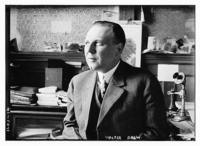





Library of Congress Prints and Photographs Division, LC-DIG-ggbain-09156.

























http://digitallibrary
.usc.edu/cdm/ref/collection/
p15799coll65/
id/4403


Photos





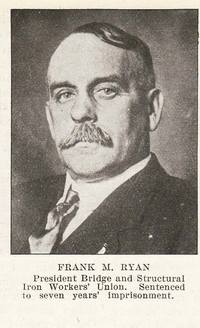


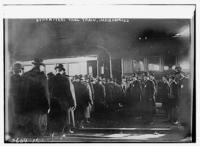











Library of Congress Prints and Photographs Division, LC-DIG-ggbain-05802.





